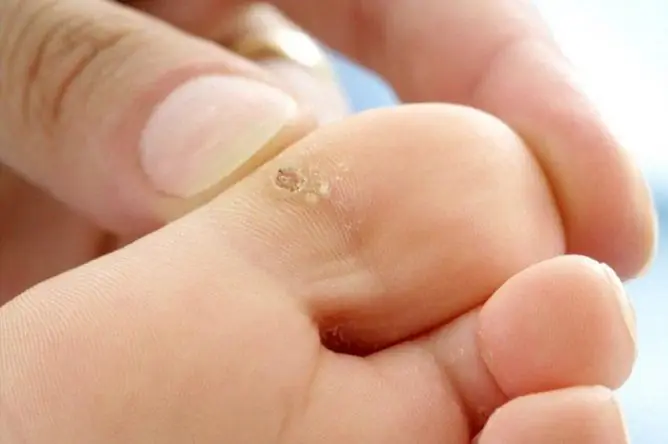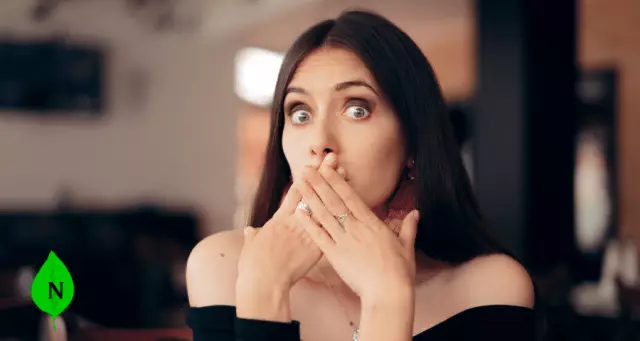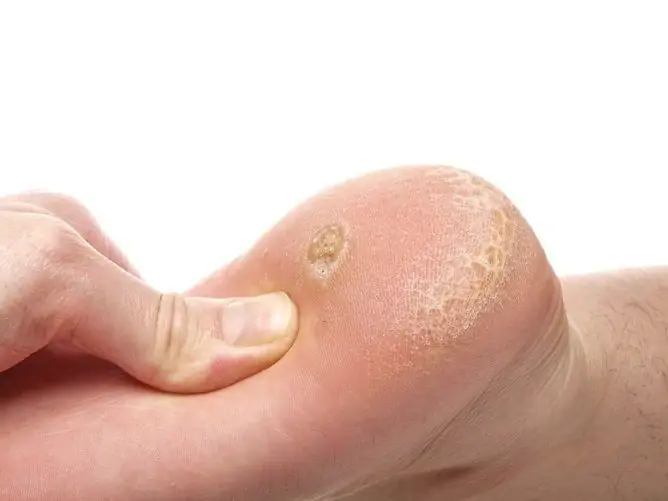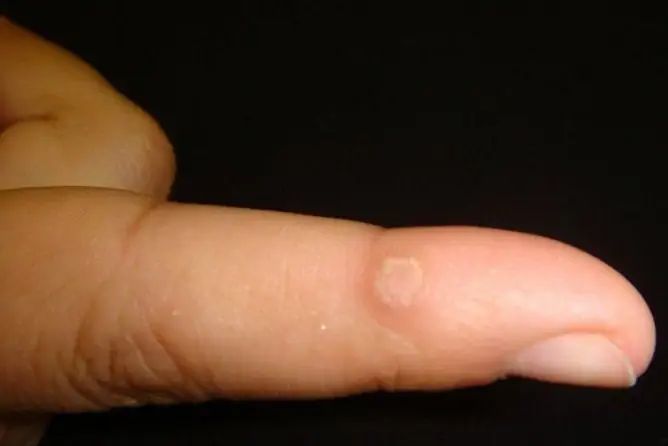- Author Rachel Wainwright [email protected].
- Public 2023-12-15 07:39.
- Last modified 2025-11-02 20:14.
Wart on toe
The content of the article:
- Reasons for the appearance
- Wart on the big toe: how it manifests
- Diagnostic methods
- Is it necessary to treat the disease
-
How to remove toe warts at home
- Advantages and Disadvantages of Home Treatment
- Simple guidelines
- Folk remedies
- Keratolytic drugs
- Antiviral drugs
- Cytostatics
- Other treatments
- Video
A wart on the toe can cause pain and discomfort when walking or playing sports. The cause of the pathology is human papillomavirus infection. Every 4th adult faces warts, but not all cases require removal of the formations. To determine the tactics of therapy, you need to consult a dermatologist, further treatment can be carried out at home.

Warts appearing on the toes may not always need to be removed
Reasons for the appearance
Warts are benign skin growths. Skin growths can occur anywhere on the body, but most often on the face, fingers, soles and toes, and genitals. The cause of their occurrence is a viral infection - the human papillomavirus (HPV). There are over 100 types of HPV, each with its own characteristics.
You can become infected with human papillomavirus infection in a bathhouse, sauna, swimming pool and other public places while walking barefoot. The virus persists on surfaces for several months, increasing the likelihood of infection. Symptoms of the disease do not appear immediately; from the moment of infection to the first manifestations, it usually takes 1 month.
The likelihood of infection increases the presence of the following factors:
- microtrauma, abrasions, cuts on the plantar side of the fingers;
- increased sweating of the legs;
- wearing uncomfortable shoes;
- dry skin, cracks.
The thing is that it is easier for viruses to get into steamed and injured skin. The onset of the disease is also influenced by general diseases - diabetes mellitus and other endocrine pathology, flat feet, arthrosis and arthritis, dermatological diseases.
Wart on the big toe: how it manifests
The main symptom of the disease is the presence of a mass on any toe (little toe, big toe) or in the interdigital space. The build-up appears mainly in places of greatest pressure and friction. What does a subcutaneous wart look like (pictured):
- the size varies from 1 mm to 1-2 cm or more, when there are several formations, and they merge;
- the surface is rough, dense;
- the shape can be different: from oval to irregular;
- whitish color;
- small black dots may appear on the surface, which represent thrombosed capillaries;
- absence of relief lines in the affected area;
- clear contours.
Warts on the toes cause a lot of inconvenience, interfere with walking, and often cause pain. Over time, the growth becomes denser, which only intensifies the symptoms.
Diagnostic methods
Before starting home treatment, you need to consult a dermatologist to confirm the diagnosis. Self-medication can be dangerous, especially if misdiagnosed. The doctor will carefully examine the neoplasm, if necessary, prescribe tests to exclude a malignant process.
What additional diagnostic methods can be prescribed:
| Research method | Explanation |
| Dermatoscopy | The primary method for the diagnosis of dermatological diseases. Under 10x magnification, you can see in detail the edges, color and shape of the formation. Dermatoscopy is indicated for all patients before starting treatment. |
| Polymerase chain reaction (PCR) | Allows you to identify the causative agent of the disease. With the help of research, you can determine the type of HPV. |
| Histological examination | It is carried out if there is a suspicion of a malignant nature of the formation, as well as with the surgical removal of the wart. |
Is it necessary to treat the disease
Not in all cases of the disease is indicated to remove the wart. In about 25% of cases, education takes place on its own.
Removal of the wart must be carried out if the following signs are present:
- rapid growth of education;
- the color, size or shape of the growth changes;
- frequent trauma;
- signs of malignancy.
Also, removal is indicated in cases where the presence of education leads to severe discomfort, accompanied by painful sensations.
How to remove toe warts at home
You can get rid of warts using different methods: minimally invasive procedures, folk recipes, medications. Many treatments are carried out in a hospital setting, but some can also be used at home (herbs, acids, antiviral ointments). The complexity of the treatment lies in the fact that after removal, the growth appears again after a while. Therefore, it is not enough just to remove the wart, it is imperative to follow the recommendations aimed at preventing relapse.
Advantages and Disadvantages of Home Treatment
Home treatment has advantages and disadvantages. The advantages include the availability of the method - no need to visit a hospital for treatment, funds can be purchased at any pharmacy. There are also disadvantages, which are much more:
- high probability of spread of infection;
- development of complications - ulceration, bleeding, attachment of bacterial flora;
- frequent relapses;
- It is difficult to completely cure the disease at home.
Simple guidelines
Treatment of skin growths has two main directions - the removal of the formation and the prevention of relapse. To prevent the formation of new warts, the following guidelines should be followed:
- Do not go barefoot in the pool, sauna, gym, or other public places.
- Observe the rules of hygiene, use only a personal towel.
- With excessive sweating of the feet, foot baths and wearing open shoes will help.
- Wear comfortable shoes that do not squeeze or chafe.
- Do not use untreated manicure accessories.
Folk remedies
At home, folk recipes based on medicinal plants or food products are usually used for treatment - celandine, potatoes, garlic, acetic acid, aloe, castor oil. Such agents have a cauterizing or destructive effect on surface tissues.
| Means | Features, cooking recipe | How to use |
| Celandine juice | Fresh stems of the plant are needed to extract the juice. |
Celandine is a poisonous plant, so you need to use it carefully: · Lubricate the skin around the formation with cream or oil; · Squeeze the juice from the stem directly onto the wart; · Wait until dry, repeat the application of celandine juice 3 times. It is recommended to lubricate the build-up 2 times a day, the course of treatment is 5 days. |
| Aloe leaves | For medicinal purposes, aloe juice is used. For the recipe, you need a freshly cut aloe leaf (gel-like pulp). |
· Lubricate the wart with soda solution (1 teaspoon of baking soda per 200 ml of water); · Attach the aloe leaf with pulp to the skin formation; · Secure using an adhesive plaster or bandage; · Leave for 4-6 hours. The procedure must be repeated daily for 10 days. |
| Garlic | For treatment, you can use chopped garlic or its juice. | Chop a clove of garlic into a gruel, apply to the skin, secure with a bandage and leave overnight. The procedure is repeated daily for 7 days. |
| Acetic acid | One of the most aggressive folk remedies for treating warts. Often, this treatment leaves a noticeable scar. | Apply vinegar to a cotton swab, attach it to the growth and fix with a bandage. Keep the bandage on for 4 hours. The procedure is repeated 2 times a day for 5 days. |
| Potatoes | Wash 1 medium potato and coarsely grate. |
You need to make a compress from potatoes: · Apply gruel to the build-up; Put polyethylene on top; · Secure with a bandage. The compress should be left overnight. The course of treatment is long - 4 weeks. |
| Castor oil | Gentle remedy. | Warts should be rubbed with castor oil 2 times a day, leaving the remedy for 30 minutes. |
Keratolytic drugs
For the treatment of pathology, drugs can be used that are able to exfoliate dead skin cells. These include salicylic acid.
How to treat with salicylic acid:
- soak your feet in warm water for 15 minutes;
- dry your feet;
- treat the affected area with pumice;
- apply salicylic acid to the build-up;
- put a bandage on top and fix it with a bandage.
Salicylic acid should be applied every day. The effect of such a procedure appears on average after 10-12 weeks.
You can also use other acidic preparations that have a keratolytic effect:
- solution for external use Kollomak (salicylic and lactic acid, polidocanol);
- Solkoderm (nitric, acetic, oxalic and lactic acid, copper nitrate).
Antiviral drugs
Topical antiviral drugs help get rid of warts. They act directly on the cause of the disease - HPV. There are no specific antiviral agents against HPV, therefore, immunomodulators are mainly used:
- Imiquimod;
- Panavir;
- Viferon;
- Aldara (Imiquimod).
You need to apply a cream or gel 3 times a week, leaving it on the skin until completely absorbed. The course of therapy is 2 to 4 weeks. Side effects from the use of antiviral ointments are rare.
Cytostatics
To eliminate warts, you can also use drugs that block cell division, such as Fluorouracil cream. You need to apply the cream pointwise 2-3 times a day. The average duration of therapy is 6 weeks.
You can also use the combined drug Verrumal, which contains fluorouracil and salicylic acid.

Verrumal is one of the drugs used to treat warts
Other treatments
Home treatment does not always get rid of the warts. With the ineffectiveness of folk remedies and medications, the use of minimally invasive surgical methods is indicated. The most common are:
- cryodestruction (removal of the formation using liquid nitrogen);
- electrocoagulation;
- curettage;
- laser removal;
- surgical excision.
Surgical or minimally invasive removal is the most effective treatment for the disease. The use of these methods is indicated in the presence of complications (ulceration, bleeding, suppuration), as well as with frequent trauma to the neoplasm.
Video
We offer for viewing a video on the topic of the article.

Anna Kozlova Medical journalist About the author
Education: Rostov State Medical University, specialty "General Medicine".
Found a mistake in the text? Select it and press Ctrl + Enter.






